- Thread starter
- #41
Chill weekend of some basic wrenching. Started off installing the shifter, so rolled the chassis out. If the body is ever destroyed I'm turning it into a Hilux-cart

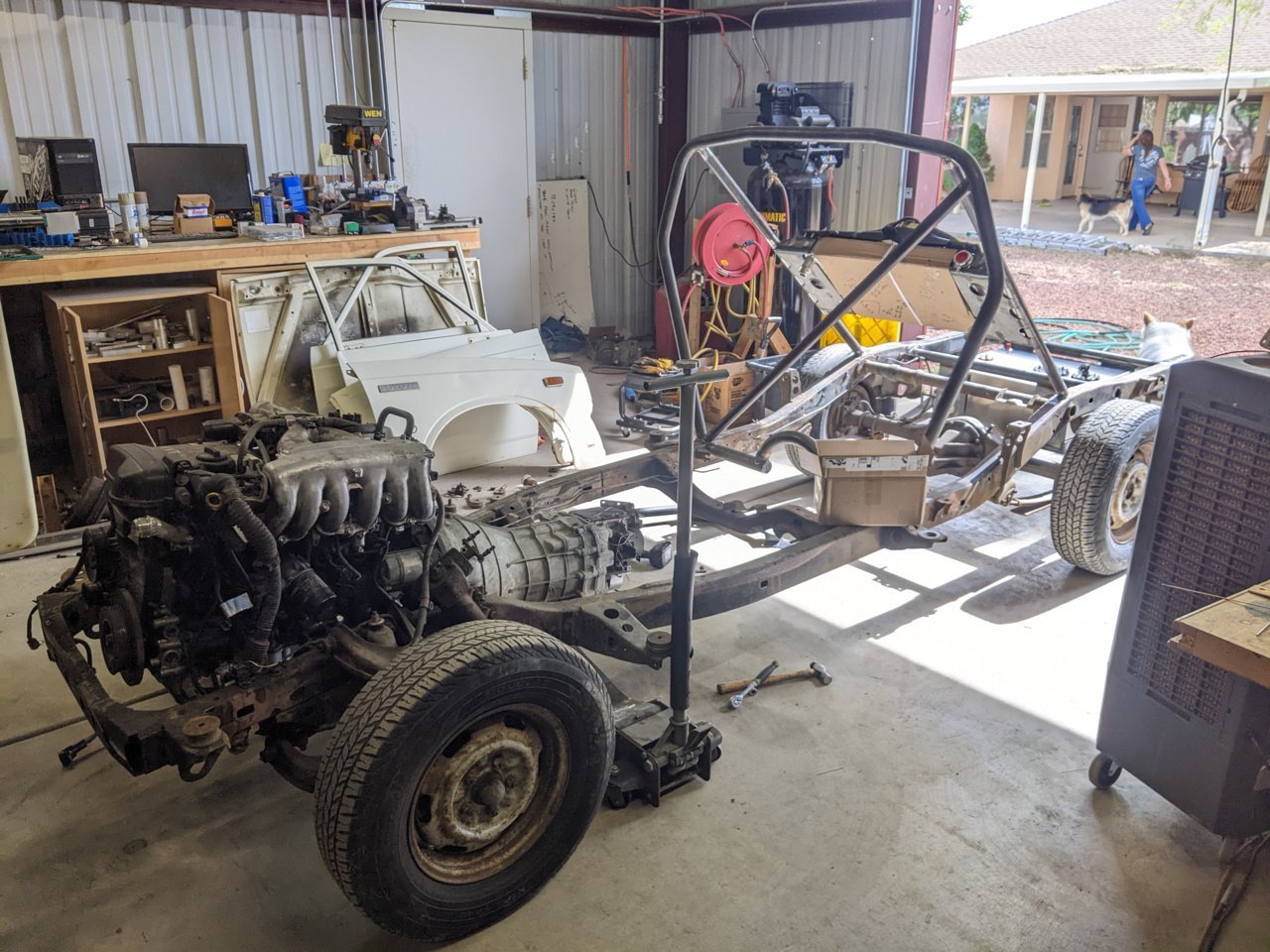
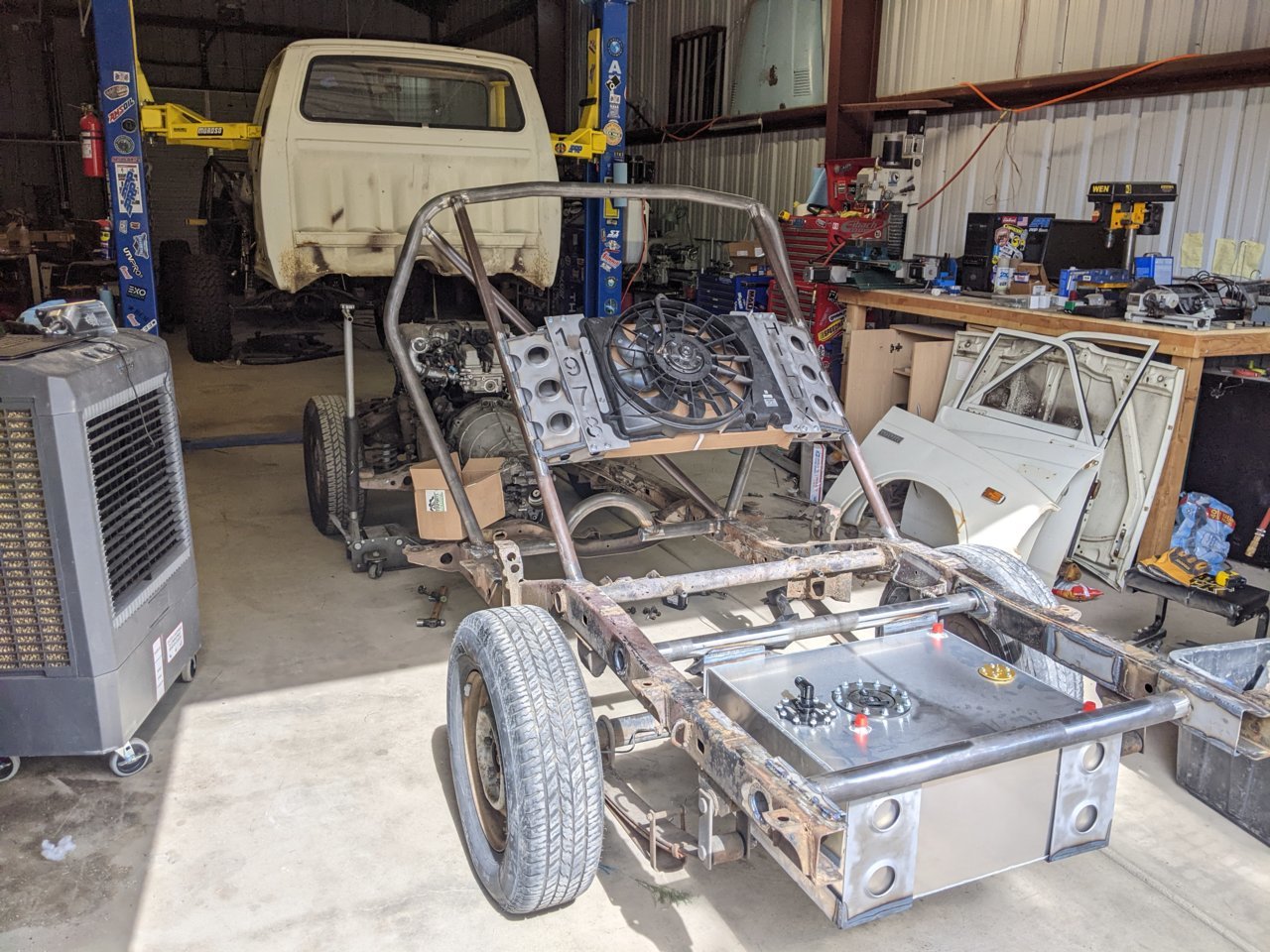
The shifter involved pulling the tail housing off the transmission.
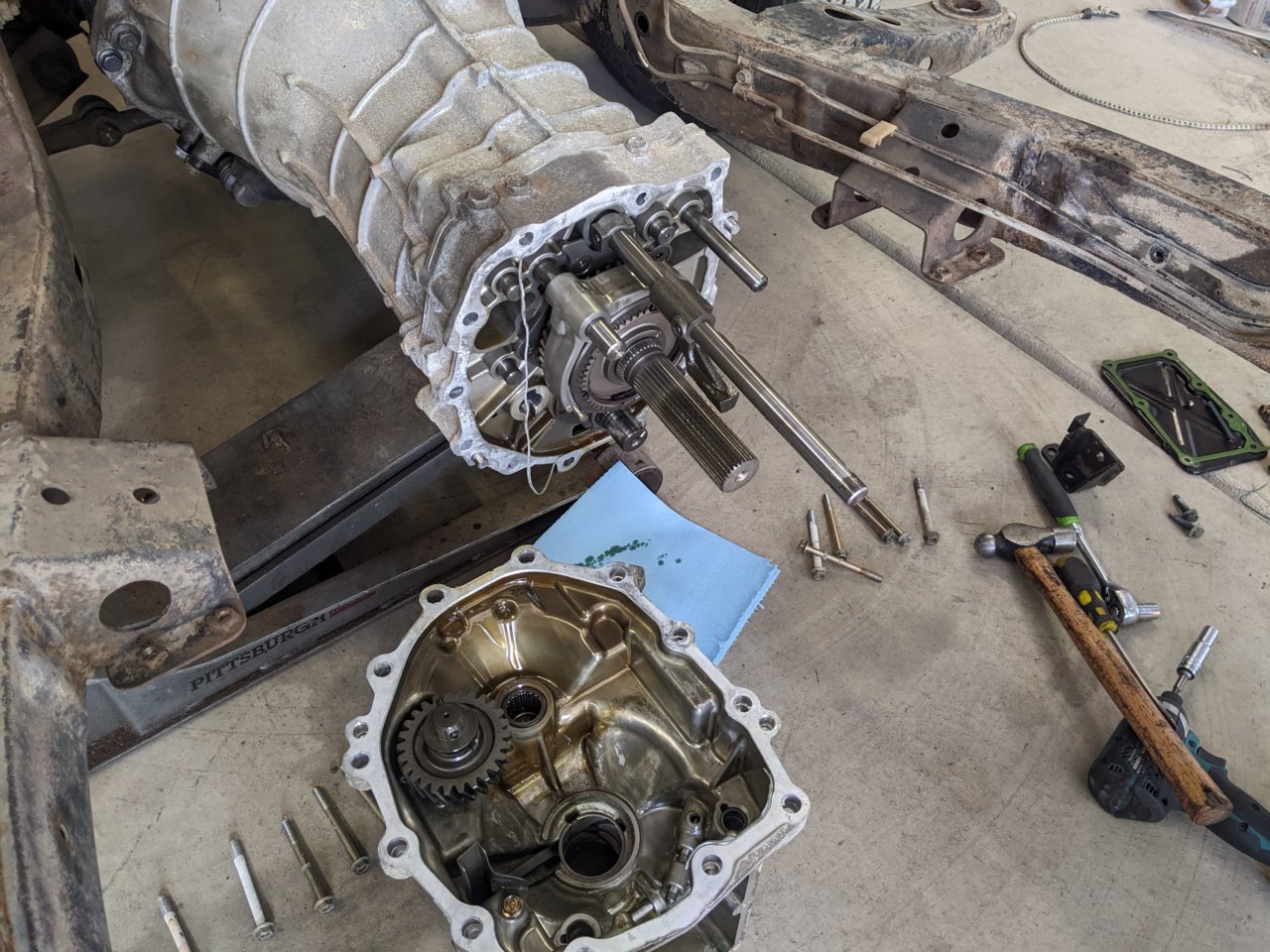
Then cutting the shaft for the shifter in half and installing these machined parts.

This allows the shifter to come straight down through the access port. The detent pin relocation bracket on the right didn't really line up with anything so I put it on the mill, made the detent stick out (engage) further and had to slot the ears to scoot it over more. After installing and reinstalling like four times and having my wife spin the engine to test that I could actually shift into gears, it was done!

The only manual I've owned is the FJ, and if has like a foot of motion in a three foot long shifter and is nice and smooth. This thing seems really tight by comparison and is REALLY short. Like there's literally an inch of motion between 1st and 5th. I think I remember reading that it shortened the shifter throw, I don't know how a stock 350z is since I never received the stock shifter, and this is the only front relocation kit I found, but holy s*** it's gonna take some getting used to. I can't even tell where reverse is either, it's someplace to the right of 6th I know and I've gotten it to engage but sitting there I can't figure out how the hell to consistently get into reverse. I mean 6th is like 1/2" to the right of 3rd, so reverse must be like 1/8" further right? It's ****ing weird, Im hoping with the engine running and stuff spinning everything will shift nicely. I might have to open it up and clearance the housing or that machined canoe thing to make sure I'm getting enough lateral motion but I have no idea hahaha
Anyways! I pieced the fuel system together, as always there was stuff I ordered wrong or still needed. Somehow I ordered all ORB-8 male fittings for the cell even though it needs AN-8 females, no idea how I totally ****ed that up.

I guess I didn't take any photos but I ran the cooling lines. I had bought 2x 10ft lengths of AN20 line and that's literally the exact length of the drivers side and has maybe 4" to spare on the passenger side
 it's so tight to the point I bought some different end fittings, and another weld on bung to try and adjust the water outlet on the drivers side of the block to point it more backwards to gain a few inches. Each of those lines was $250 so I'm going to the effort to make the 10ft length work since buying another longer line and then shortening it to 10ft 2in will cost a metric assload hahaha
it's so tight to the point I bought some different end fittings, and another weld on bung to try and adjust the water outlet on the drivers side of the block to point it more backwards to gain a few inches. Each of those lines was $250 so I'm going to the effort to make the 10ft length work since buying another longer line and then shortening it to 10ft 2in will cost a metric assload hahaha
Moving on, I started setting up the brakes and clutch pedal. I first made this bracket to hold all the reservoirs and stuff.
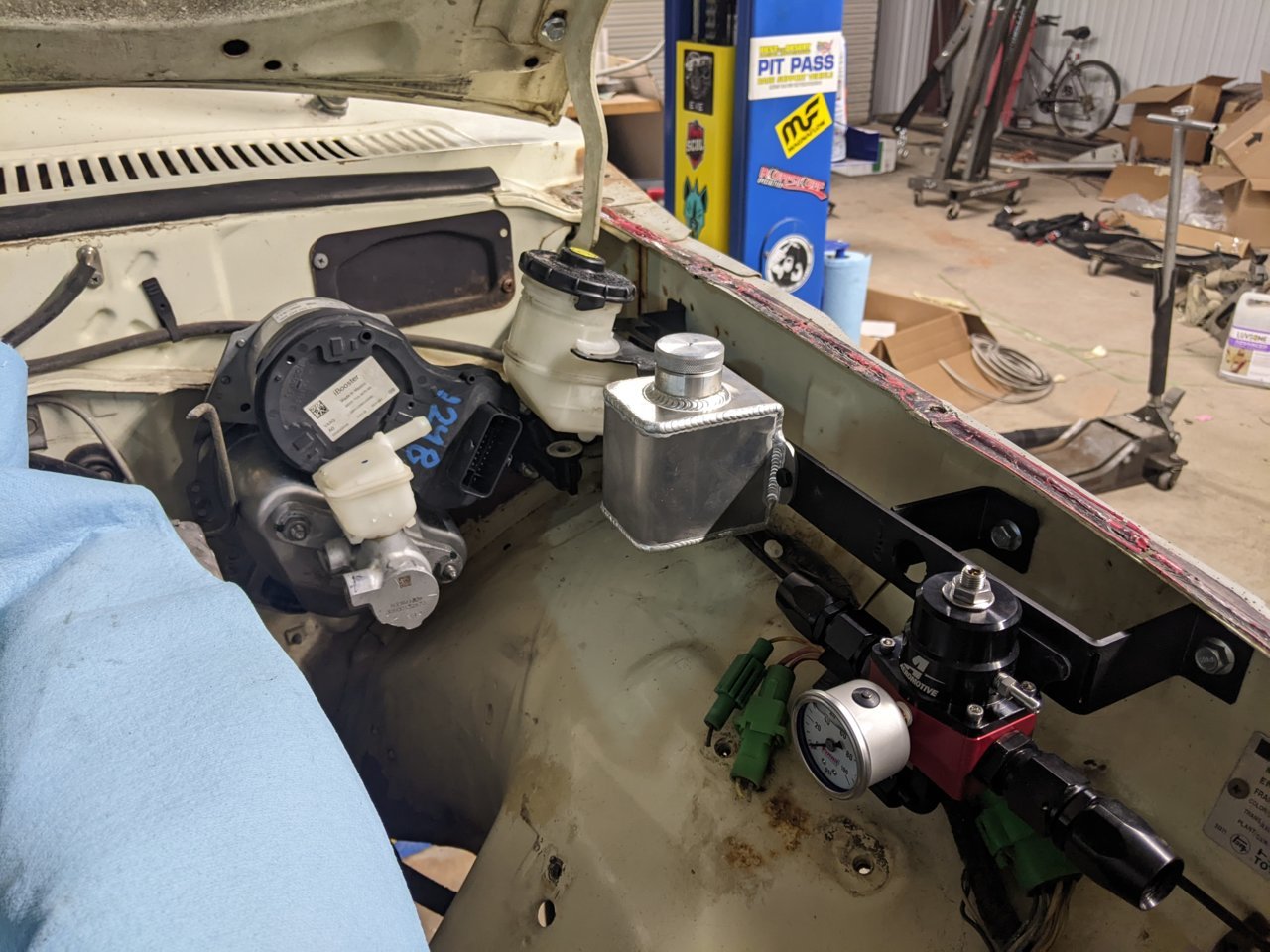
I ended up not mounting the brake reservoir there since the hood hits it plus it's kissing the brake booster. I actually still haven't figured out a nice place to put it, since keeping it slightly higher than the brake booster is a pain. Some people machine custom mini resis that replace that little plastic housing on the booster, maybe do that? Or maybe that little plastic housing holds enough and I can skip the remote reservoir? There's also a Tesla Model S reservoir that fits but is like $100 on eBay and would direct mount to the booster.
Speaking of which, I found the plugs in a kit in the US for the booster so ordered that. This is a Bosch ibooster gen 2 off of a Honda Accord and all it needs is 12V to give boost, no vacuum or anything. I drilled out the firewall for the studs and it fit right up! Very excited about this, the Hilux will have the most modern brakes of anything I own! Maybe will upgrade the FJs booster to this too.
The silver reservoir is for the clutch. And then there's the fuel regulator too.
Next I pulled the intake off to replace the spark plugs and ended up deleting every vacuum line I could, pulling the intake apart completely and removing this weird ass valve and then scrubbing it and trying to clean it up.


Waiting on the spark plugs now and a PCV. I also received a serpentine tensioner which was missing from the engine, and bought a replacement pulley for it since I had to change the belt routing since I'm not running AC or PS. I installed that today so the serpentine is now on. Also ordered some vacuum line plugs so just need to cap everything off and put spark plugs in and the engine can be wired up. I still need to figure out the exhaust too, I chopped the stock one up a bit and cut the cats out but will need a bit more massaging to stuff the exhaust manifolds in.
Let's see.... I had to modify the brake and clutch pedals, for now keeping all the stock hardware. I had to install a threaded spacer for the clutch pedal since the wilwood master is a lot shorter than the stock one I guess. I also cut the clutch pedal up and pushed it 6" to the left. For some reason the stock clutch pedal was like below the steering wheel? Really weird. The brake pedal was in a good spot but I had to install a little extension piece to line up with the brake booster. The booster doesn't have a threaded rod so couldn't install a coupler to extend it so just welded a blob on the end to extend it.
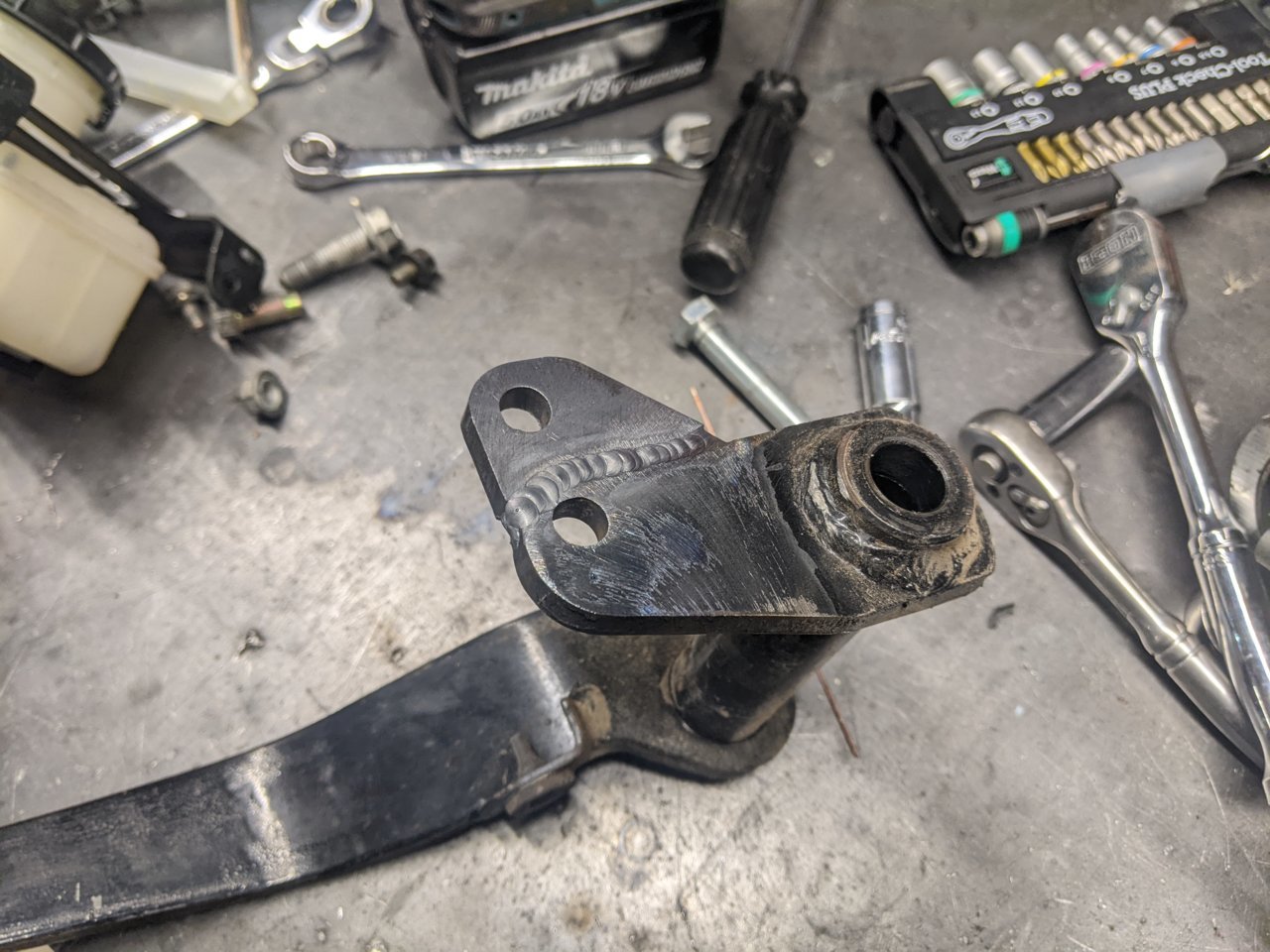

I have an order from summit showing up tomorrow for the fuel, clutch, and brake fittings I'm missing. Also pulled measurements for the driveshaft so hopefully get that on order locally tomorrow. Ordered some 8deg axle shims to set the rear caster for the driveshaft. Huge order of Deutsch connectors and wiring and fuse block stuff--i think I'll rewire the entire truck at the end of the day. And a bunch of other random s*** on order. I have high hopes this is the last set of orders to get the truck driving, I know I need some more stuff like a throttle cable so probably one order left to really "finalize" it for the first drive. Getting super close! A lot of this is just tedious stuff of unbolting and fitting and measuring over and over, but as of today it's almost entirely plumbing left (and then Jerry rig some wiring).
Lots of talking in this post, not a lot of pictures or cool stuff, but that means we're getting close!

The shifter involved pulling the tail housing off the transmission.
Then cutting the shaft for the shifter in half and installing these machined parts.
This allows the shifter to come straight down through the access port. The detent pin relocation bracket on the right didn't really line up with anything so I put it on the mill, made the detent stick out (engage) further and had to slot the ears to scoot it over more. After installing and reinstalling like four times and having my wife spin the engine to test that I could actually shift into gears, it was done!
The only manual I've owned is the FJ, and if has like a foot of motion in a three foot long shifter and is nice and smooth. This thing seems really tight by comparison and is REALLY short. Like there's literally an inch of motion between 1st and 5th. I think I remember reading that it shortened the shifter throw, I don't know how a stock 350z is since I never received the stock shifter, and this is the only front relocation kit I found, but holy s*** it's gonna take some getting used to. I can't even tell where reverse is either, it's someplace to the right of 6th I know and I've gotten it to engage but sitting there I can't figure out how the hell to consistently get into reverse. I mean 6th is like 1/2" to the right of 3rd, so reverse must be like 1/8" further right? It's ****ing weird, Im hoping with the engine running and stuff spinning everything will shift nicely. I might have to open it up and clearance the housing or that machined canoe thing to make sure I'm getting enough lateral motion but I have no idea hahaha
Anyways! I pieced the fuel system together, as always there was stuff I ordered wrong or still needed. Somehow I ordered all ORB-8 male fittings for the cell even though it needs AN-8 females, no idea how I totally ****ed that up.
I guess I didn't take any photos but I ran the cooling lines. I had bought 2x 10ft lengths of AN20 line and that's literally the exact length of the drivers side and has maybe 4" to spare on the passenger side

Moving on, I started setting up the brakes and clutch pedal. I first made this bracket to hold all the reservoirs and stuff.
I ended up not mounting the brake reservoir there since the hood hits it plus it's kissing the brake booster. I actually still haven't figured out a nice place to put it, since keeping it slightly higher than the brake booster is a pain. Some people machine custom mini resis that replace that little plastic housing on the booster, maybe do that? Or maybe that little plastic housing holds enough and I can skip the remote reservoir? There's also a Tesla Model S reservoir that fits but is like $100 on eBay and would direct mount to the booster.
Speaking of which, I found the plugs in a kit in the US for the booster so ordered that. This is a Bosch ibooster gen 2 off of a Honda Accord and all it needs is 12V to give boost, no vacuum or anything. I drilled out the firewall for the studs and it fit right up! Very excited about this, the Hilux will have the most modern brakes of anything I own! Maybe will upgrade the FJs booster to this too.
The silver reservoir is for the clutch. And then there's the fuel regulator too.
Next I pulled the intake off to replace the spark plugs and ended up deleting every vacuum line I could, pulling the intake apart completely and removing this weird ass valve and then scrubbing it and trying to clean it up.
Waiting on the spark plugs now and a PCV. I also received a serpentine tensioner which was missing from the engine, and bought a replacement pulley for it since I had to change the belt routing since I'm not running AC or PS. I installed that today so the serpentine is now on. Also ordered some vacuum line plugs so just need to cap everything off and put spark plugs in and the engine can be wired up. I still need to figure out the exhaust too, I chopped the stock one up a bit and cut the cats out but will need a bit more massaging to stuff the exhaust manifolds in.
Let's see.... I had to modify the brake and clutch pedals, for now keeping all the stock hardware. I had to install a threaded spacer for the clutch pedal since the wilwood master is a lot shorter than the stock one I guess. I also cut the clutch pedal up and pushed it 6" to the left. For some reason the stock clutch pedal was like below the steering wheel? Really weird. The brake pedal was in a good spot but I had to install a little extension piece to line up with the brake booster. The booster doesn't have a threaded rod so couldn't install a coupler to extend it so just welded a blob on the end to extend it.
I have an order from summit showing up tomorrow for the fuel, clutch, and brake fittings I'm missing. Also pulled measurements for the driveshaft so hopefully get that on order locally tomorrow. Ordered some 8deg axle shims to set the rear caster for the driveshaft. Huge order of Deutsch connectors and wiring and fuse block stuff--i think I'll rewire the entire truck at the end of the day. And a bunch of other random s*** on order. I have high hopes this is the last set of orders to get the truck driving, I know I need some more stuff like a throttle cable so probably one order left to really "finalize" it for the first drive. Getting super close! A lot of this is just tedious stuff of unbolting and fitting and measuring over and over, but as of today it's almost entirely plumbing left (and then Jerry rig some wiring).
Lots of talking in this post, not a lot of pictures or cool stuff, but that means we're getting close!
